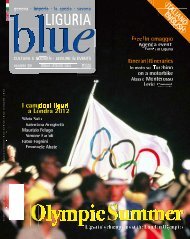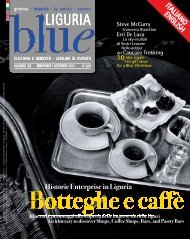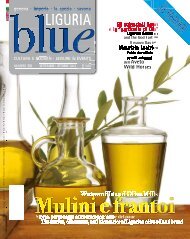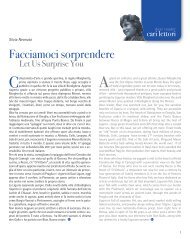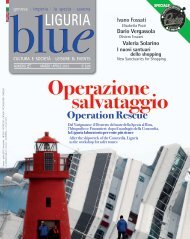Download PDF - Blue Liguria - Sagep
Download PDF - Blue Liguria - Sagep
Download PDF - Blue Liguria - Sagep
You also want an ePaper? Increase the reach of your titles
YUMPU automatically turns print PDFs into web optimized ePapers that Google loves.
lue inventors<br />
In <strong>Liguria</strong> come<br />
nel Wyoming<br />
<strong>Liguria</strong> Is Like Wyoming<br />
Qualcuno l'ha chiamata il<br />
"Wyoming d'Italia", in onore dello<br />
stato americano dei pellerossa e<br />
delle grandi foreste. La <strong>Liguria</strong> è<br />
ricoperta per il 70% da boschi<br />
(posti, manco a dirlo, nel 61% dei<br />
casi su versanti con pendenze<br />
superiori al 40%) ed è, insieme<br />
con il Trentino, la regione italiana<br />
con più superficie boscata - 375<br />
mila ettari - rispetto a quella<br />
totale.<br />
Anche per questo Tiziano Fratus -<br />
37 anni, piemontese, scrittore<br />
naturalista e poeta delle foreste,<br />
in questi giorni nelle librerie con<br />
l'ultimo Manuale del perfetto<br />
cercatore di alberi - ha censito in<br />
terra ligure numerose piante di<br />
grande interesse storico naturale.<br />
Tra queste l’albero più antico è il<br />
cipresso di Vernazza (800 anni),<br />
ma Sanremo è pieno di ficus<br />
macrofilla centenari, a Mallare va<br />
esplorata la faggeta secolare del<br />
Benevento, e «Genova - spiega -<br />
conserva “tesori” nei parchi di<br />
Pegli, Nervi e Villa Serra di<br />
Comago»<br />
It has been called the “Wyoming<br />
of Italy”. This is because, like<br />
Wyoming, <strong>Liguria</strong> is covered - 70%<br />
- by woods and forests, not to<br />
mention that here, like there, 61%<br />
of the trees in <strong>Liguria</strong> grow on<br />
slopes that are steeper than 40%.<br />
Together with Trentino, <strong>Liguria</strong> is<br />
the Italian region with the<br />
greatest amount forest cover –<br />
375,000 hectares – in proportion<br />
to the total. This is one of the<br />
reasons why the poet from the<br />
Piedmont, Tiziano Fratus, 37,<br />
naturalist and writer has taken a<br />
census on <strong>Liguria</strong>n lands of the<br />
many plants of great interest,<br />
which he lists in his latest book,<br />
the manual of the perfect treeseeker,<br />
“Manuale del Perfetto<br />
Cercatore di Alberi”. The oldest<br />
tree in <strong>Liguria</strong> is the cypress of<br />
Vernazza (800 years old), though<br />
Sanremo holds hundred year old<br />
macrofilla centenary figs, and<br />
Mallare has the centuries-old<br />
beech woods of Benevento. And<br />
Genoa “There are treasures”, he<br />
explains, “in the parks of Pegli,<br />
Nervi, and Villa Serra di Comago.”<br />
poi raccontarli attraverso libri, mostre fotografiche,<br />
laboratori di educazione ambientale per<br />
grandi e piccini, escursioni guidate.<br />
«Ho iniziato ad occuparmi di grandi alberi alcuni<br />
anni fa, quando sono andato a Singapore e negli<br />
Stati Uniti per promuovere i<br />
miei libri di poesia e mi sono<br />
trovato al cospetto di grandi<br />
città, paesaggi straordinari e<br />
alcuni alberi davvero maestosi<br />
- racconta Fratus - Mi sono<br />
subito sentito in sintonia con<br />
il creato, non più sradicato come<br />
mi era capitato da adolescente<br />
e nei miei vent’anni.<br />
Tornato in Italia ho iniziato a<br />
interessarmi agli alberi monumentali,<br />
ho raccolto informazioni<br />
e ho scritto il mio primo<br />
libro in prosa, Homo Radix. Da<br />
quando mi occupo di alberi mi<br />
sento sempre a casa, che mi<br />
trovi sull’isola di Jersey, nella<br />
Manica, in Portogallo, in Polonia<br />
o in California.<br />
Gli alberi mi aiutano a pulire la<br />
mente: quando sono agitato,<br />
arrabbiato o confuso chiudo il<br />
Tiziano Fratus vive in Val Sangone, una<br />
valle del Torinese poco lontano dalla Val<br />
di Susa. Il suo ultimo lavoro è Manuale<br />
del perfetto cercatore di alberi<br />
Tiziano Fratus lives in Val Sangone, one of<br />
the Alpine valleys near Turin, not far from<br />
the Val di Susa. His latest book is just out<br />
in the bookshop<br />
computer, stacco con la civiltà e me ne vado a fare<br />
una lunga passeggiata in un bosco. Mi svuoto, mi<br />
riposo, respiro a fondo e tutto si mette in ordine. E<br />
non è solo una ricerca letteraria: io mi sento davvero<br />
un uomo-radice che attraversa il paesaggio».<br />
Fratus, che alla stesura di libri e itinerari affianca<br />
un percorso di documentazione fotografica che ha<br />
dato vita a un vasto archivio, oggetto di mostre, ha<br />
diviso i suoi titoli in due filoni: da una parte la poesia,<br />
dall’altra il percorso Homo Radix.<br />
Il lavoro sui grandi alberi è dedicato in parte alle<br />
città – Torino, Genova, Milano, Palermo, perché<br />
anche nei tessuti urbani sopravvivono alberi antichi<br />
– e in parte ai paesaggi di campagna. Sono appena<br />
usciti Manuale del perfetto cercatore di alberi<br />
per Feltrinelli e Il sussurro degli alberi per<br />
Ediciclo. E poi un volume dedicato ai bambini, Ci<br />
vuole un albero, nato da una serie di laboratori<br />
nelle scuole. «Perché credo che sia importante gettare<br />
dei semi. Amare la natura, gli alberi e gli animali<br />
è questione di carattere e di propensione personale<br />
ma anche di educazione. Chi ama gli alberi<br />
spesso ha avuto come primo insegnante un nonno<br />
che gli mostrava i castagni, i ciliegi, le conifere,<br />
i faggi. I libri indirizzati all’educazione ambientale,<br />
con un tocco di leggerezza e di fantasia,<br />
possano essere importanti».<br />
“I began dealing with big trees a few years ago,<br />
when I went to Singapore and the United States to<br />
promote my books on poetry. I found myself in the<br />
presence of big cities, extraordinary landscapes, and<br />
trees that were truly majestic,” Fratus tells us. “I felt<br />
myself in instant harmony with<br />
creation, no longer rootless as I<br />
had been as an adolescent and<br />
in my twenties. Returning to<br />
Italy I began to check out<br />
monumental trees. I gathered<br />
information, and I wrote my first<br />
book in prose, Homo Radix,<br />
which then brought to life a<br />
series of publications on which I<br />
am still working today. Ever<br />
since I began my interest in<br />
trees, I feel at home everywhere,<br />
whether it is Jersey in the<br />
English Channel, or Portugal or<br />
Poland, or California. Trees help<br />
me clear my mind.<br />
When I am stressed, angry, or<br />
confused, I turn off my<br />
computer, detach myself from<br />
civilization, and go take a long<br />
walk in the woods. I empty<br />
myself, begin to relax. I breathe<br />
in deeply. And all somehow seems to come back<br />
together. Mine is not just a literary research: I feel<br />
myself rooted, a man-root, in the landscape.”<br />
Along with his book-writing and itineraries, Fratus<br />
walks a “path” of photographic documentation<br />
which has brought to life a vast archive, the subject<br />
of exhibitions.<br />
He has divided his titles into two threads: poetry<br />
and Homo Radix. His work on great trees has been<br />
dedicated in part to cities – Turin, Genoa, Milan,<br />
Palermo, because in their urban fabric ancient trees<br />
still live – and in part to the countryside. Feltrinelli<br />
has just published his Manuale del perfetto<br />
cercatore di alberi (The Manual for the Perfect Treeseeker)<br />
and Ediciclo, his Il sussurro degli alberi (The<br />
Whisper of the Trees).<br />
He also has a book dedicated to children, Ci vuole<br />
un albero, We Need a Tree, that was born in a series<br />
of workshops for schools. “Because I feel it is<br />
important to plant seeds. Loving nature, trees,<br />
animals, is a question of character and a personal<br />
inclination, but it is also a matter of education.<br />
Those who love trees have often had as their first<br />
teacher a grandfather who showed them chestnuts,<br />
cherry trees, pines, and beeches. Books on<br />
environmental education with a touch of fantasy<br />
and lightness can be very important.”<br />
20



